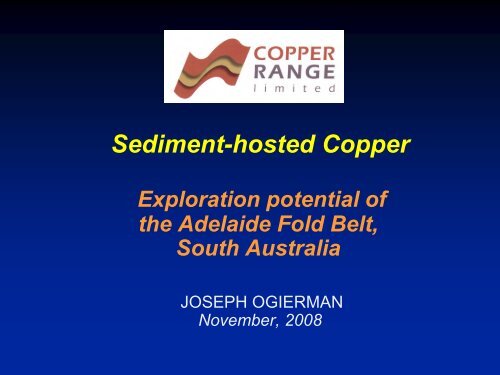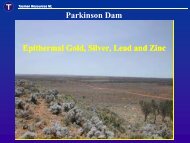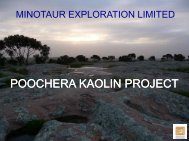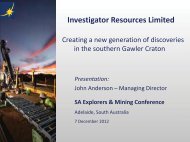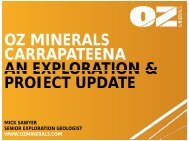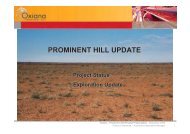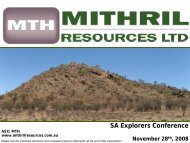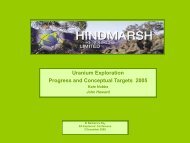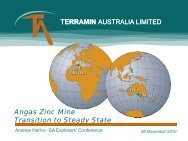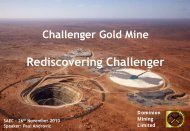Sediment hosted copper - Saexplorers.com.au
Sediment hosted copper - Saexplorers.com.au
Sediment hosted copper - Saexplorers.com.au
You also want an ePaper? Increase the reach of your titles
YUMPU automatically turns print PDFs into web optimized ePapers that Google loves.
<strong>Sediment</strong>-<strong>hosted</strong> Copper<br />
Exploration<br />
potential of<br />
the Adelaide Fold Belt,<br />
South Australia<br />
JOSEPH OGIERMAN<br />
November, 2008
CRJ in South Australia
Cu Mining in South Australia –<br />
a brief summary<br />
1842 - first Cu Mine in Australiaa - Kapunda<br />
1850s - Burra Mine producing 10% world’s Cu<br />
1860 - Discovery Moonta / Walla<br />
aroo<br />
1940s - Cu mining essentially ceased<br />
1970s - revival of Cu Mining with<br />
re-opening of Burra,<br />
Kanmantoo and Mt Gunson<br />
1988 - opening Olympic Dam<br />
2007 - opening Prominent Hill
Cu Exploration in<br />
the AFB in 21 st C<br />
WHY<br />
??<br />
• Last “serious” attempt at SSC was in<br />
the 1970s (Utah) - exploration approach<br />
“model driven” using Zambian syngenetic Cu template.<br />
• Since recognition of IOCG-style mineralisation in 1980s the AFB has been<br />
largely forgotten<br />
• Understanding of sediment-<strong>hosted</strong> mineralisation has advanced since 1970s –<br />
multiphase diagenetic/epigenetic models<br />
• Copper Range is applying new understanding of sediment-<strong>hosted</strong> Cu<br />
mineralisation to the AFB.
<strong>Sediment</strong>ary-Cu deposits;<br />
SUB-TYPES - REDUCED FACIES eg. African Copper Belt ; Kupferschiefer;<br />
- REDBED Cu eg. Corocoro<br />
- REVETT eg. Dzhezkazgan (450 M tonnes @ 1.5% Cu)<br />
- PARADOX BASIN eg. Constellation<br />
Several Types but Similar Processes involved;<br />
Multiple fluid events ranging from initial Diagenetic to<br />
late-stage Epigenetic (syn or post-Orogenic)
PARADOX BASIN – UTAH<br />
(Thorson<br />
Model)<br />
• SANDSTONE HOST FOR DISSEMINATED Cu –<br />
favourable lithology due to high porosity / permeability<br />
• MULTIPLE FLUID EVENTS NECESSARY FOR DEPOSIT FORMATION<br />
• 1 sT STAGE - Diagenetic Fluids Form Iron Oxides – “RED BEDS”
Thorson, 2008
PARADOX BASIN – UTAH<br />
(Thorson<br />
Model)<br />
• MULTIPLE FLUID EVENTS NECESSARY FOR DEPOSIT FORMATION<br />
• 1 sT STAGE - Diagenetic Fluids Form Iron Oxides – “RED BEDS”<br />
• 2 nd STAGE - Reducing Fluids “Prepare” host sandstone by<br />
converting hematite to pyrite , hydrocarbons<br />
important as source of reductant<br />
Reducing fluids<br />
bleach Red Beds ---- “Grey Beds”
Thorson, 2008
Fracture control of bleaching, Salt Anticline, Utah
PARADOX BASIN – UTAH<br />
(Thorson<br />
Model)<br />
• MULTIPLE FLUID EVENTS NECESSARY FOR DEPOSIT FORMATION<br />
• 1 sT STAGE - Diagenetic Fluids Form Iron Oxides – “RED BEDS”<br />
• 2 nd STAGE - Reducing Fluids “Prepare” host sandstone by<br />
converting hematite to pyrite , hydrocarbons<br />
important as source of reductant<br />
• 3 rd STAGE - Epigenetic Cu-Bearing saline fluids introduced<br />
along structural feeder zones. Ppt Cu on contact<br />
with reductants<br />
in “Grey Beds”
Thorson, 2008
Broad Scale Alteration — Bleaching<br />
from<br />
T. MacIntyre, CSM MS 2006<br />
CASHIN MINE<br />
Thorson, 2008<br />
Cashin mine area (Utah) with bleaching (iron oxide destruction) of<br />
Wingate Sandstone and upper units moving out from Cashin f<strong>au</strong>lt.
AFB<br />
B –<br />
FACTORS FOR SSC<br />
MINERALISATION<br />
• LARGE BASIN<br />
The AFB has sufficient sufficient subsidence (>3km) to generate petroleum<br />
and warm aqueous reducing brines<br />
• SOURCE ROCKS<br />
• SALINE BRINES<br />
Arkosic Red Beds and Mafic Volcanics in basal Callana Gp<br />
Cu-endowed Basement<br />
(Gawler/Curnamona Craton)<br />
Evaporite horizons in Callana + possibly in Burra Gp<br />
• STABLE FLUID FLUX<br />
Sr-Rb isotopes suggest stable, convectional intrabasinal fluids<br />
leaching Cu from volcanics - terminated 580Ma (Foden et al, 2001)<br />
• REDUCTANTS<br />
Carbon and Py-bearing shales (eg Tindelpinna); Hydrocarbons in Burra<br />
Gp rocks (Belperio,1987) and Cambrian Limestone (Santos, 1956)<br />
• FLUID FOCUS Basin-bounding f<strong>au</strong>lts ,sub-basins / basement highs, diapirs<br />
• KNOWN Cu MINES<br />
Over 800 recorded Cu occurrences in AFB including several small mines
AFB<br />
B –<br />
SIGNS of SSC MINERALISATION<br />
• REDOX SETTINGS –<br />
PPT of Cu at multiple REDOX interfaces throughout basin eg<br />
Tapley Hill Formation (Kapunda, Copley, Stuart Shelf),<br />
Skillogalee Dolomite (Burra, Copper Claim?)<br />
• SANDSTONE-HOSTED –<br />
Never been tested<br />
in AFB. Mention of sst-<strong>hosted</strong> Cu<br />
mineralisation at various prospects eg. Kanyaka, Copper Claim,<br />
“Thorson-like” model can be applied to explain sst-<strong>hosted</strong><br />
mineralisation at Mt Gunson on Stuart Shelf.<br />
• FEEDER ZONES -<br />
Structures with Qtz+Cu sulphide veining associated with<br />
stratabound mineralisation at Kapunda and Copper Claim<br />
• CHALLENGES -<br />
One of biggest problems in Australia is the “regolith<br />
problem” – difficult to distinguish alteration from weathering
KAPUNDA MINE
TARGET SELECTION<br />
• BREACHED ANTICLINES – WORUMBA,<br />
CARRIETON ANTICLINE<br />
• UNBREACHED ANTICLINES – TARNMA<br />
ANTICLINE
• Although there is evidence for various styles of SSC<br />
mineralisation, CRJ is not ‘Model-driven”<br />
• We are not looking for replicas of Paradox or other basins –<br />
not restricted by “basin envy”<br />
• Its all about the process – each basin is unique<br />
• Need understanding of evolving basin history – hydrology, diagenesis,<br />
hydrocarbon production, metamorphism, alteration etc<br />
• CRJ has generated drill targets for 2009, “there is still life in the AFB”<br />
v v v v<br />
v<br />
v<br />
v<br />
v<br />
v


